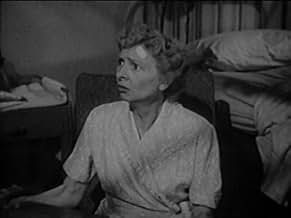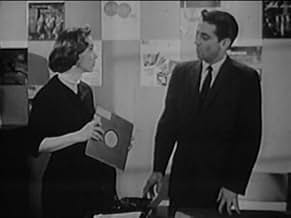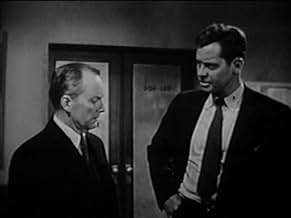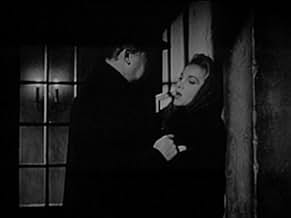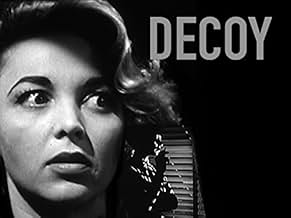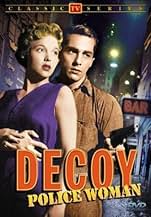New York City policewoman Casey Jones' assignment to fight crime often entails her going undercover in some of the seediest and most dangerous parts of the city.New York City policewoman Casey Jones' assignment to fight crime often entails her going undercover in some of the seediest and most dangerous parts of the city.New York City policewoman Casey Jones' assignment to fight crime often entails her going undercover in some of the seediest and most dangerous parts of the city.
Browse episodes
Storyline
Did you know
- TriviaThe first cop show with a female protagonist.
- Crazy creditsOpening credits include the dedication: "Presented as a tribute to the BUREAU OF POLICEWOMEN Police Department City of New York."
Featured review
The original DRAGNET TV series ran from 1951 to 1959 until Jack Webb decided to cancel it after 8 seasons despite continued high ratings. DRAGNET became the template for every cop show that followed including a second DRAGNET that ran from 1968-1971. The many police programs in its wake included DECOY which featured a woman as its main character. That choice of character made it the flip side to DRAGNET which was male dominated. DECOY starred Beverly Garland as policewoman Patricia "Casey" Jones and lasted for a single season (39 episodes) between 1957-58. In the majority of those episodes (25 out of 39), Casey went undercover to catch the criminals which accounts for the title of the series. But there are several further differences between the two shows besides the female undercover officer.
To begin, DRAGNET was a West Coast produced show centering around Los Angeles (filmed at Walt Disney Studios) with very little location shooting whereas DECOY was centered in New York City and incorporated lots of location shooting. Interior shots were done in the old Biograph Studios where D. W Griffith once worked. DRAGNET's performers were mostly from the movie industry while those in New York came from television and the NY stage. Jack Webb was already well known in Hollywood and, in addition to being the creator-star, was also the head of production. DECOY's head of production was Stuart Rosenberg, an unknown TV director who would go on to a successful Hollywood career (COOL HAND LUKE, THE AMITYVILLE HORROR).
Each DRAGNET episode opened with "The story you are about to see is true, only the names have been changed to protect the innocent" DECOY's disclaimer came not at the beginning but at the end of each episode and read "This story is based on actual cases. All names and places are fictitious for obvious reasons" And as Casey Jones was the main character, each DECOY episode opened with "Presented as a Tribute to Bureau of Policewomen, Police Department Of New York City". Also each program opened with a New York locale before the title credit appeared. A celebrated, retired policewoman, Officer Margaret Leonard, who served as the inspiration for the Casey Jones character, was credited as the technical advisor for the show.
However the greatest difference between the two series lay in the storylines. In DRAGNET, each program was your basic "Chase 'Em, Catch 'Em, & Convict 'Em" while DECOY's was "Chase 'Em, Catch Em & And Try To Understand 'Em". Sgt. Joe Friday was just an ordinary, everyday, hardworking cop doing his routine job. Policewoman Casey Jones was given more exciting fare. She got to pose as everything from a high class call girl to a fashion model to a nightclub singer to lure and flush out the bad guys. Once they were duly apprehended, Casey would address the camera to point out how it was the faults of Society that created criminals. DRAGNET on the other hand closed with the criminals being tried, convicted, and sentenced according to the severity of their crime, minus explanations. You do the crime, you do the time.
While Jack Webb was the ideal personification of Joe Friday (as it should be since he created Joe), I can't say the same for Beverly Garland as "Casey" Jones. Garland was a very capable actress as proved in a number of 1950s B movies. She could be really tough when called for as shown in SWAMP WOMEN and GUNSLINGER (both 1956). In DECOY, however, I found her a little too glam to be entirely believable as an undercover cop. Class and charm might work for the occasional high end assignment but not for the majority of the down and out characters she also impersonated, such as a nightclub singer or woman's prison inmate. I blame the producers and 1950s sensibilities for this approach. My choice for the role would have been Ida Lupino, who had more grit.
Having said this, DECOY has two things going for it. 1) New York City locations ca.1957. We are given the rare opportunity to glimpse iconic NYC locations such as Penn Central station, Horn & Hardart Automat, The Stork Club, Charlie Parker's Birdland Jazz Club, Colony Records on Times Square, and Sardi's Restaurant. While shooting on location the cameras were hidden so passersby were unaware of what was going on and didn't stop to stare, lending authenticity. And 2) The secondary performers. While DECOY gives us old pros like Al Lewis, Vincent Gardenia, Albert Dekker, and Frank Silvera, it's the up and coming talent like Colleen Dewhurst, Martin Balsam, Ed Asner, Lois Nettleton, Larry Hagman, Frank Sutton, Suzanne Pleshette, and Peter Falk on the cusp of their careers that are really interesting to see. Almost all of them hailed from the New York stage and would later make their marks in television.
Although inspired by and modeled on DRAGNET, DECOY explored controversial subject matter which DRAGNET expressly avoided. Topics such as obscene phone calls, heroin addiction, gun running, dysfunctional families, spousal abuse, and mental illness. Unlike DRAGNET which had several episodes in the can before it aired, DECOY's shows were shot only two weeks in advance before broadcast. Ultimately the controversial subject matter of some the shows coupled with the social commentary-like endings discouraged would-be advertisers and the series was cancelled after one season due to lack of funds. Now, thanks to Film Chest Media, all 39 episodes are available on 3 CDs with lots of bonus materials for a very good price.... For more reviews see The Capsule Critic.
To begin, DRAGNET was a West Coast produced show centering around Los Angeles (filmed at Walt Disney Studios) with very little location shooting whereas DECOY was centered in New York City and incorporated lots of location shooting. Interior shots were done in the old Biograph Studios where D. W Griffith once worked. DRAGNET's performers were mostly from the movie industry while those in New York came from television and the NY stage. Jack Webb was already well known in Hollywood and, in addition to being the creator-star, was also the head of production. DECOY's head of production was Stuart Rosenberg, an unknown TV director who would go on to a successful Hollywood career (COOL HAND LUKE, THE AMITYVILLE HORROR).
Each DRAGNET episode opened with "The story you are about to see is true, only the names have been changed to protect the innocent" DECOY's disclaimer came not at the beginning but at the end of each episode and read "This story is based on actual cases. All names and places are fictitious for obvious reasons" And as Casey Jones was the main character, each DECOY episode opened with "Presented as a Tribute to Bureau of Policewomen, Police Department Of New York City". Also each program opened with a New York locale before the title credit appeared. A celebrated, retired policewoman, Officer Margaret Leonard, who served as the inspiration for the Casey Jones character, was credited as the technical advisor for the show.
However the greatest difference between the two series lay in the storylines. In DRAGNET, each program was your basic "Chase 'Em, Catch 'Em, & Convict 'Em" while DECOY's was "Chase 'Em, Catch Em & And Try To Understand 'Em". Sgt. Joe Friday was just an ordinary, everyday, hardworking cop doing his routine job. Policewoman Casey Jones was given more exciting fare. She got to pose as everything from a high class call girl to a fashion model to a nightclub singer to lure and flush out the bad guys. Once they were duly apprehended, Casey would address the camera to point out how it was the faults of Society that created criminals. DRAGNET on the other hand closed with the criminals being tried, convicted, and sentenced according to the severity of their crime, minus explanations. You do the crime, you do the time.
While Jack Webb was the ideal personification of Joe Friday (as it should be since he created Joe), I can't say the same for Beverly Garland as "Casey" Jones. Garland was a very capable actress as proved in a number of 1950s B movies. She could be really tough when called for as shown in SWAMP WOMEN and GUNSLINGER (both 1956). In DECOY, however, I found her a little too glam to be entirely believable as an undercover cop. Class and charm might work for the occasional high end assignment but not for the majority of the down and out characters she also impersonated, such as a nightclub singer or woman's prison inmate. I blame the producers and 1950s sensibilities for this approach. My choice for the role would have been Ida Lupino, who had more grit.
Having said this, DECOY has two things going for it. 1) New York City locations ca.1957. We are given the rare opportunity to glimpse iconic NYC locations such as Penn Central station, Horn & Hardart Automat, The Stork Club, Charlie Parker's Birdland Jazz Club, Colony Records on Times Square, and Sardi's Restaurant. While shooting on location the cameras were hidden so passersby were unaware of what was going on and didn't stop to stare, lending authenticity. And 2) The secondary performers. While DECOY gives us old pros like Al Lewis, Vincent Gardenia, Albert Dekker, and Frank Silvera, it's the up and coming talent like Colleen Dewhurst, Martin Balsam, Ed Asner, Lois Nettleton, Larry Hagman, Frank Sutton, Suzanne Pleshette, and Peter Falk on the cusp of their careers that are really interesting to see. Almost all of them hailed from the New York stage and would later make their marks in television.
Although inspired by and modeled on DRAGNET, DECOY explored controversial subject matter which DRAGNET expressly avoided. Topics such as obscene phone calls, heroin addiction, gun running, dysfunctional families, spousal abuse, and mental illness. Unlike DRAGNET which had several episodes in the can before it aired, DECOY's shows were shot only two weeks in advance before broadcast. Ultimately the controversial subject matter of some the shows coupled with the social commentary-like endings discouraged would-be advertisers and the series was cancelled after one season due to lack of funds. Now, thanks to Film Chest Media, all 39 episodes are available on 3 CDs with lots of bonus materials for a very good price.... For more reviews see The Capsule Critic.
- TheCapsuleCritic
- Aug 25, 2024
- Permalink
- How many seasons does Decoy have?Powered by Alexa
Details
- Runtime30 minutes
- Color
- Sound mix
- Aspect ratio
- 1.33 : 1
Contribute to this page
Suggest an edit or add missing content


